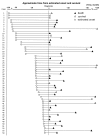A distinct subtype of Epstein-Barr virus-positive T/NK-cell lymphoproliferative disorder: adult patients with chronic active Epstein-Barr virus infection-like features
- PMID: 29242302
- PMCID: PMC6058795
- DOI: 10.3324/haematol.2017.174177
A distinct subtype of Epstein-Barr virus-positive T/NK-cell lymphoproliferative disorder: adult patients with chronic active Epstein-Barr virus infection-like features
Abstract
The characteristics of adult patients with chronic active Epstein-Barr virus infection are poorly recognized, hindering early diagnosis and an improved prognosis. We studied 54 patients with adult-onset chronic active Epstein-Barr virus infection diagnosed between 2005 and 2015. Adult onset was defined as an estimated age of onset of 15 years or older. To characterize the clinical features of these adults, we compared them to those of 75 pediatric cases (estimated age of onset <15 years). We compared the prognosis of adult-onset chronic active Epstein-Barr virus infection with that of patients with nasal-type (n=37) and non-nasal-type (n=45) extranodal NK/T-cell lymphoma. The median estimated age of onset of these lymphomas was 39 years (range, 16-86 years). Compared to patients with pediatric-onset disease, those in whom the chronic active Epstein-Barr virus infection developed in adulthood had a significantly decreased incidence of fever (P=0.005), but greater frequency of skin lesions (P<0.001). Moreover, hypersensitivity to mosquito bites and the occurrence of hydroa vacciniforme were less frequent in patients with adult-onset disease (P<0.001 and P=0.0238, respectively). Thrombocytopenia, high Epstein-Barr virus nuclear antigen antibody titer, and the presence of hemophagocytic syndrome were associated with a poor prognosis (P=0.0087, P=0.0236, and P=0.0149, respectively). Allogeneic hematopoietic stem cell transplantation may improve survival (P=0.0289). Compared to pediatric-onset chronic active Epstein-Barr virus infection and extranodal NK/T-cell lymphoma, adult-onset chronic active Epstein-Barr virus infection had a poorer prognosis (P<0.001 and P=0.0484, respectively). Chronic active Epstein-Barr virus infection can develop in a wide age range, with clinical differences between adult-onset and pediatric-onset disease. Adult-onset chronic active Epstein-Barr virus infection is a disease with a poor prognosis. Further research will be needed.
Copyright © 2018 Ferrata Storti Foundation.
Figures




Comment in
-
Defining the elusive boundaries of chronic active Epstein-Barr virus infection.Haematologica. 2018 Jun;103(6):924-927. doi: 10.3324/haematol.2018.193714. Haematologica. 2018. PMID: 29866887 Free PMC article. No abstract available.
References
-
- Cohen JI. Epstein-Barr virus infection. N Engl J Med. 2000;343(7):481–492. - PubMed
-
- Williams H, Crawford DH. Epstein-Barr virus: the impact of scientific advances on clinical practice. Blood. 2006;107(3):862–869. - PubMed
-
- Straus SE. The chronic mononucleosis syndrome. J Infect Dis. 1988;157(3):405–412. - PubMed
-
- Jones JF, Shurin S, Abramowsky C, et al. T-cell lymphomas containing Epstein-Barr viral DNA in patients with chronic Epstein-Barr virus infections. N Engl J Med. 1988;318(12):733–741. - PubMed
-
- Okano M, Kawa K, Kimura H, et al. Proposed guidelines for diagnosing chronic active Epstein-Barr virus infection. Am J Hematol. 2005;80(1):64–69. - PubMed
Publication types
MeSH terms
Substances
LinkOut - more resources
Full Text Sources
Other Literature Sources
Molecular Biology Databases

